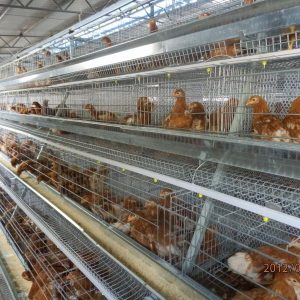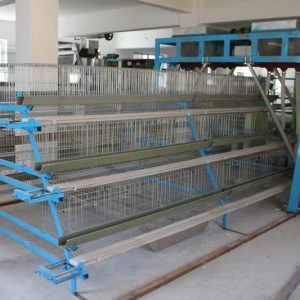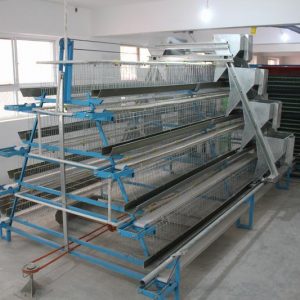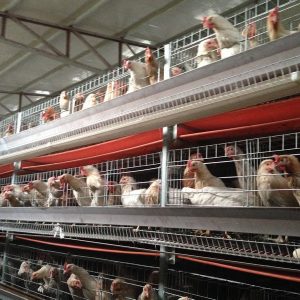
What are the factors that affect the feed intake of laying hens?
Technical service personnel and marketing personnel in production are often helpless because farmers complain about high feed intake. In fact, the feed intake of laying hens is affected by many factors, which are now explained as follows:
First, the intake of different varieties varies greatly:
Our most common varieties such as Hyacinth Brown, Hyacinth Gray, and Hyacinth White (W-36) have very different feed intakes between these different layers, for example, the theoretical feed intake of Hailan Brown Shell in spring and autumn is 110-115 grams, and Highland White is 100 grams. The same is for brown-shell laying hens, and the intakes of Hailan brown, Issa brown (lower feed intake), Roman brown, and Jinghong 1 also differ. Due to the irresponsibility of individual parent breeder farms and the difficulty of distinguishing breeds, it often happens that Jinghong No. 1 with a low feed intake was purchased, but because the high feed intake of Romain Brown was actually raised. Understand, even complain to the feed mill. Everyone must feed their layer hens according to the nutritional requirements and feed intake of different breeds, and they must not deliberately limit feeds because of the precautions of feed intake, thereby affecting the performance of the egg production performance of the breed.
Second, environmental factors:
Laying hens in the appropriate ambient temperature, the energy needs can be estimated according to this formula: calories/day. only = W(140-2T)+2E+5△W. Where W is the weight of the layer hen at the time, in kilograms; T is the average ambient temperature in degrees Celsius; E is the average daily egg production of a single chicken (grams), which is the egg production rate% × average egg weight (grams); △W is the average weight gain (especially for chickens before 35 weeks, which consume more energy due to rapid weight gain). Feed intake of layer hens at this time (g) = actual energy required per day (calories/day. only) × 1000 ÷ metabolic energy of feed (calories/kg).
1. Different seasons, different cold-proof and heat-proof conditions in the chicken house, seriously affect the feed intake: under the appropriate environment (13-23 ℃), the temperature decreases, the energy required for the chicken increases, and the feed intake increases; otherwise, the feed intake decreases. When the ambient temperature exceeds 23℃, the decrease in feed intake caused by heat stress will greatly exceed the estimated value of the above formula: for every 1℃ increase in temperature, the feed intake decreases by 1.4-1.6% (Lille1976); At ℃, the temperature increased by 1 ℃, and the feed intake decreased by 1-1.5 g/day. Only at 32-36 ℃, the temperature increased by 1 ℃, and the feed intake decreased by 4.2 g/day. In winter, houses with large space, dark humidity, poor insulation, and fewer laying hens must have a high feed intake; while open and semi-open chicken houses with poor heatstroke and cooling conditions in summer, the house temperature is high and the feed intake It must be low (low food intake, insufficient nutrient intake, negative nutrition balance in chickens, physical decline, difficult to maintain during the peak period, and it is easy to induce epidemics-“accounting after autumn”). In order to reduce the impact of the environment on the laying hens, it is best to build something that keeps warm in winter and cool in summer in a high-lying place, and has a suitable height (3.2-3.5 meters) chicken house; there should be at least 3 house heights between the chicken houses. In order to avoid the front house from blocking the sun in the back house; in summer, use fans, wet curtains, water spray and other measures to increase the feed intake (night feeding).
2. The small environment of the chicken house affects the feed intake of laying hens: the ventilation of the chicken house, ammonia gas and carbon dioxide concentration affect the chicken feed intake. Under appropriate environmental conditions, the production performance of chickens is fully exerted, the egg production rate is high, the health is high, and the chickens have a high feed intake; on the contrary, in the environment with poor ventilation and excessive carbon dioxide and ammonia, especially in winter for heat preservation Ignoring ventilation, the health of the flock and the performance of the egg production are reduced, and the feed intake is low. Under the same temperature conditions, the amount of ventilation is large (the wind speed is higher), the chicken dissipates heat faster, and the body temperature is lower, and the feed intake of the flock is naturally higher.
3. Factors such as own weight and production performance affect feed intake:
It can be seen from the above formula for energy requirement assessment of laying hens that the intake of chickens with large body weight must be high. Suppose we take a 32-week chicken as an example: the house temperature is 18°C, the egg production rate is 90%, the average egg weight is 60 grams, and the weight gain is 3 grams per day (about 2-3 grams per day). We make a comparison between chickens weighing 1.9 kg and 1.5 kg. If all use 2650 calories/kg of feed. Body weight requires energy: 1.9 (140-2×18)+2×90%×60+5×3=1.9×104+123=320.6 kcal/day. Only; small body weight (1.5 kg) is: 1.5 ×104+123=279 kcal/day. Only. Their feed intake was 320.6 kcal×1000÷2650=121 g/day. only and 279 kcal×1000÷2650=105.3 g/day. only, the difference between them was 15.7 g/day. only. That is to say, a large chicken needs to eat more than 3 yuan of feed per day. The comparison is to make everyone understand that a large chicken needs high energy and a large feed intake. But everyone should not have the wrong idea that low-weight chickens consume less material and have high efficiency. In reality, the average-weight chickens are better than small-weight chickens in terms of egg production rate, egg weight, and health status. Will produce better economic benefits. For the same reason, chickens with good egg production performance produce more eggs and consume more material. Assuming that the chickens weighing 2 kg weigh under the above conditions, one lays 95% of the eggs and the average egg weight is 66 grams; the other is the egg production rate of 90% and the average egg weight is 62 grams. Let’s make a comparison (the average weight gain of chickens weighing 2 kg is negligible). Chickens with 95% egg production and an average egg weight of 66 g require energy: 2(140-2×18)+2×95%×66=2×104+125.4=333.4 kcal/day. Only; 90% egg production A chicken with an average egg weight of 62 grams requires energy: 2(140-2×18)+2×90%×62=319.6 kcal/day. Only. The feed intake is: 333.4 kcal×1000÷2650=125.8 g/day. Only 319.6 kcal×1000÷2650=120.6 g/day. Only the difference between them is 5.2 g/day. Only.
Fourth, due to brooding, different breeding periods, different management levels, and different nutritional levels, the feed intake of the flocks is very different.
1. Chickens raised in the autumn and winter seasons with lower temperatures, due to the appropriate temperature and lower ambient temperature, the chickens have higher feed intake and full intestinal development. Such chickens generally have a larger body weight and higher feed intake after birth. On the contrary, in the summer, brooding and rearing, due to the high heat and heat, the chicken feed intake is low, the development of the intestinal tract is restricted, the birth weight is low, and the feed intake is generally not high.
2. The nutrition and management of brooding and rearing affect the feed intake of laying hens: the nutrient level of feed in brooding and rearing is high (the proportion of bran added is low, and fat is added), and the use of high nutrient brooding feed takes longer. Feeding time is short, so the overall feed intake of such chickens will not be high. Especially in the flocks that are in the high temperature in summer after brooding, rearing or starting production in summer, once the amount of bran added is too low or no bran is added, the feed intake of such flocks will be very low to meet the nutrition after laying eggs Bring difficulties. Of course, for flocks with short brooding time (take 0-6 weeks brooding mode) and long brooding time, due to the low nutrient broiler feed used for a longer time (more than 8 weeks), plus more than 14% bran added during brooding The use of low-energy concentrates and full-price feeds during the above or growing period will cause the chickens to consume a high amount of feed after the start of production, and cause serious waste of feed. Especially if such chickens catch up with the autumn and winter seasons, the feed intake will be unusually high.
3. The water consumption of laying hens has a great influence on the feed intake: in spring and autumn, the water consumption of laying hens is generally 1.8-2 times of the feed intake. Laying hens with sufficient water intake have high feed intake and good egg production performance. In practice, the number of nipple drinkers in the farmer, the level of the water pressure of the pressure reducing valve, and the drinking mode (nipple drinking or sink drinking) are different, which have a great impact on the drinking volume of laying hens. For those with insufficient drinking water due to low drinking water pressure and insufficient nipple quantity, their feed intake will inevitably be low, and the egg production performance of such chickens will not be very good.
Fifth, the nutritional level of feed seriously affects feed intake:
1. For chickens with low feed metabolic energy, the feed intake will be high: under the premise of suitable temperature and feed nutrition balance (the protein-energy ratio of different seasons and different stages and the nutritional energy ratio of basic acids and vitamins are relatively fixed ), laying hens are “energy-based”, under the same conditions, the daily intake of high-energy balanced diets of the same chicken will be lower than that of low-energy diets. Let’s compare the above with 95% egg production and an average egg weight of 66 grams. Under the above conditions (weight 2 kg, temperature 18°C), when the feed metabolic energy is 2650 kcal/kg, it will theoretically eat The amount is 125.8 g/day. Only (see “three” calculation above). If the metabolic energy of the feed is 2500 kcal/kg, then its theoretical feed intake is: 333.4 kcal×1000÷2500=133.4 g/day. Only. Compared to 125.8 g/day. The feed intake of each chicken is 7.6 g per chicken per day. This is the core of using low-energy and low-cost feeds to make money with low energy and low prices (increasing feed intake). In production, due to the low utilization rate of feed digestion with low metabolic energy, the losses caused to farmers are far from increasing the amount of feed intake.
2. The nutritional balance of the feed affects the amount of feed intake: We talk about the “energy feeding” of laying hens, which refers to the balanced nutritional diet under suitable temperature conditions. When the temperature is too high, too low, or the nutrition is not balanced, the lever adjustment function of the chicken can break. For example, when the levels of crude protein, lysine, and methionine are low, the chicken will break the limit of higher metabolic energy of the formula and meet the needs of the lowest amino acids through higher intake. This is why when we use so-called “high energy and low protein” with high energy, low crude protein, low amino acids, and low vitamins, to break the energy ratio formula (the feed with 5% 20% soybean meal is the most prominent), even in the formula When the metabolic energy is high, the reason for the high feed intake of laying hens is still high. This will cause the chickens to consume excessively high energy in order to consume the lowest crude protein, amino acids and other nutritional requirements, resulting in excess energy. This not only results in poor production performance caused by insufficient nutrient intake of layer hens, but it is also prone to relatively high energy intake, and metabolic diseases such as fatty liver appear, increasing the death rate of farmers. Of course, under high-energy and low-nutrition levels, the regulation effect of chickens is limited. For example, when the lysine level is too low, the chicken feed intake will be greatly reduced and “to show resistance”!
3. The quality and addition ratio of raw materials affect the intake of laying hens: the content of various nutrients in the raw materials is the value when the dry matter content is 86-87%. When the dry matter content is more or less, it will affect the laying hens. Feed intake. Taking corn as an example, the metabolic energy of 86% of dry matter content (less than 14% of water content) is about 3240 kcal/kg, but the new corn has high moisture content, low dry matter content and reduced energy when the water content is 16-20%. When the addition ratio is unchanged, the feed intake will increase. In actual work, corn contains more than 14% water, and every additional 1% requires the addition of about 0.3-0.4% of high-quality vegetable oil to balance energy loss. The change of the proportion of the same large formula will affect the feed intake. For example, if 4% corn is removed from the formula and 4% bran is added, the metabolic energy of corn is 3240 kcal/kg, and the metabolic energy of bran is 1600 kcal/kg. Calories/kg. Assuming that the laying hens need energy of 320 kcal per day at this stage, the original metabolic energy of the feed is 2650 kcal/kg, and the theoretical feed intake is: 320×1000÷2650 kcal/kg=120.8 g/day. Only; add 4 After removing 4% corn from the bran, the feed metabolic energy is 2650-64=2586 kcal/kg, the theoretical feed intake is: 320×1000÷2586 kcal/kg=123.7 g/day. Only, the difference between the two is 123.7 -120.8 g/day. Only = 3 g/day. Only. Suppose 10,000 chickens eat at least 60 kg of feed per day.
Sixth, different regions have a great influence on the feed intake of laying hens: my country has a vast territory, different natural conditions, and different raw material quality and addition ratios, resulting in great differences in feed intake of the same breed of hens raised at the same time. This is not only the impact of the annual average temperature, day-night temperature difference, light time, geographical features and monsoon, but also the differences brought about by the breeding habits, management level and nutrition level, which is a comprehensive result. For example, my country’s northeastern and southern provinces; coastal areas and inland areas; Yunnan, Shandong, Hebei and other hens have very different feed intakes.
The feed intake of laying hens is the result of a combination of factors. The same nutrient level of feed, in the same breed of layer, will also be due to different regions, different environments, different batches, different egg production stages, different seasons, different management levels, and different raw material quality. There is a difference in feed intake. Not to mention the different nutrient levels of feed, the greater the difference in feed intake in different regions, different varieties, and different management conditions. Our laying hen breeding bosses (households) should do the following: According to the variety and nutrition standards, combined with seasons, production performance, production purposes, select the corresponding premix and raw materials, design a suitable large formula to meet nutritional needs To maximize the production potential of fine varieties and create greater value. As for the feed intake, it is always a reference value for a specific situation.



